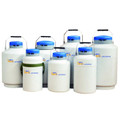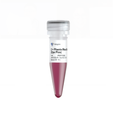 Loading... Please wait...
Loading... Please wait...- Home
- Vazyme
- Reagents for Molecular Biology Research
- PCR
- High-Fidelity PCR
- 2 × Phanta Max Master Mix P515
Product Description
Product Description
Phanta Max Super-Fidelity DNA Polymerase is a new generation superior enzyme based on Phanta DNA Polymerase for robust PCR with higher fidelity. The unique extension factor, specificity-promoting factors and plateau un-inhibitory factor newly added to Phanta Max greatly improve its long-fragment amplification ability, specificity, and PCR yield. Phanta Max is capable of amplifying long fragments such as 40 kb λDNA, 40 kb plasmid DNA, 20 kb genomic DNA and 10 kb cDNA. The amplification error rate of Phanta Max is 128-fold lower than that of conventional Taq and 6-fold lower than that of Pfu. In addition, Phanta Max has a good resistance to PCR inhibitors and can be used for direct PCR amplifications of bacteria, fungi, plant tissues, animal tissues, and even whole blood samples. Phanta Max contains two monoclonal antibodies inhibit- ing the 5'→3' polymerase activity and 3'→5' exonuclease activity at room temperature, which enable Phanta Max to perform hot start PCR with great specificity. This kit contains Phanta Max Super-Fidelity DNA Polymerase, dNTP, and an optimized buffer system. It contains all required reaction components, except primers and templates, thereby simplifying the operation process and improving the detection throughput and repeatability. Protective agents in the 2 × Phanta Max Master Mix enable the resistance to repeated freezing and thawing. Amplification will generate blunt-ended products, which are compatible with ClonExpress and TOPO cloning kits (Vazyme #C112/C113/C115/C601).
Citation
Product Features
Ultra-high fidelity:
The fidelity is 128 times that of Taq DNA Polymerase;
Faster amplification:
The limit speed can reach 0.5 sec/kb, 30 sec/kb can efficiently amplify most fragments;
Longer amplification:
The effective amplification length of simple templates such as plasmid and λ DNA can reach 40 kb, the effective amplification length of genome can reach 20 kb, and the effective amplification length of cDNA can reach 10 kb;
Wide adaptability:
It is suitable for the amplification of various GC content fragments, has super tolerance to PCR inhibitors, and can be used for direct PCR of a variety of samples;
Simple operation:
Dye premix, minimize experimental steps.
Key Data
1. Excellent high GC amplification capacity
The 654 bp, 900 bp, 800 bp, 1,200 bp, 1,400 bp and 426 bp target fragments were amplified using the human genome as a template, and the GC content of each amplicon was higher than 68%.

2. Trusted amplification fidelity

3. Stable crude amplification ability

Components
| Components | P515-01 | P515-02 | P515-03 |
| 2 × Phanta Max Master Mix | 1 ml | 5 × 1 ml | 15 × 1 ml |
Storage
Store at -30 ~ -15℃ for up to 18 months, and transport at ≤0℃.
▲ Avoid repeated freezing and thawing.
FAQ
Q1: The amplification efficiency is low and there are no amplified bands in the test group.
A1: (1) Primers
Check whether the synthetic primers have degraded due to improper storage; review primer design and use BLAST to examine primer specificity or redesign primers.
(2) Template
Long-term storage or repeated freeze-thaw cycles will lead to DNA breakage, nicking, or degradation, so the template should be the freshly prepared double-stranded DNA. An excessively high GC content in the template will make it difficult to separate DNA double strands; in this case, add PCR Enhancer (Cat. No. P021) to effectively lower the melting temperature. Crude sample templates may contain inhibitors, so it is recommended to lower the template concentration (use after dilution; if a plant leaf is used, make sure the plant is not rich in polysaccharides or polyphenols, take a fresh, young leaf, and trim it to the size of the end of a yellow pipette tip). If cDNA is used, check the purity and integrity of the RNA used for reverse transcription.
(3) Enzyme
The enzyme used in the reaction has been inactivated. Repeat the experiment with a fresh enzyme or an enzyme from another source.
(4) Amplification system
The reaction system has been prepared incorrectly. Repeat the experiment with the correct system.
(5) Reaction program
Check whether the denaturation temperature is correct and whether the temperature displayed on the PCR system is the same as the actual temperature. If the temperature is too high, the enzyme will be rapidly inactivated in the first few cycles. If the temperature is too low, the template will not be completely denatured. If yeast is used as the template, the pre-denaturation time may be extended to 10 minutes. If the annealing temperature is inappropriate, determine the appropriate annealing temperature by testing a gradient of annealing temperatures. If the target fragment is long, try the touchdown PCR program. Check whether the extension time is sufficient.
Q2: The amplified bands are faint.
A2: (1) Primers
Check whether the synthetic primers have degraded.
(2) Template
Check the quality of the template. Long-term storage or repeated freeze-thaw cycles will lead to DNA breakage, nicking, or degradation, so the freshly prepared double-stranded DNA should be used as the template. If the template has been used up, use serial dilutions of the initial amplification product as the templates for subsequent amplification.
(3) Reaction program
Try the touchdown PCR program; increase the extension time and the number of cycles.
Q3: Amplification specificity is poor, or there are non-specific products.
A3: (1) Primers
Primer design is not optimal. If primers have bound to non-specific sites in the target sequence or to each other to form dimers, optimize by reducing the primer concentration or redesigning primers if necessary.
(2) Template
If the template is impure or contaminated, prepare a new template.
If the template has degraded, or too much template has been used, examine the integrity and concentration of the template by electrophoresis, and purify the template again if necessary. Consult the Instructions for Use for the template input amount.
(3) Reaction program
The reaction program is not optimal. If there are non-specific miscellaneous bands smaller than the target band, increase the annealing temperature and reduce the number of cycles. If there are non-specific miscellaneous bands larger than the target band, reduce the extension time and the number of cycles.
Q4: The bands are diffuse or smeared when amplification products are run on a gel.
A4: (1) Gel
Melt the gel completely during preparation.
(2) Primers
Check whether the primers have degraded.
(3) Template
The template is degraded or excessive. Examine the integrity and concentration of the template by electrophoresis, and prepare a new template if necessary. Consult the Instructions for Use for the template input amount. If the target band is long and the cDNA is used as the template, check the purity and integrity of the RNA used for reverse transcription, and perform reverse transcription again without random primers.
(4) Reaction program
The reaction program is not optimal. If the annealing temperature is inappropriate, determine the appropriate annealing temperature by testing a gradient of annealing temperatures. Try the touchdown PCR program.
Q5: There are amplification products in the blank control (NTC) group.
A5: (1) Problematic primer design
The amplified sequence is homologous to the non-target sequence. Thus, non-target sequences are also amplified in PCR.
(2) If the band corresponding to the amplification product has the same size as the target bands, this indicates contamination.
Repeat the experiment with a fresh Mix, water, or primers. Prepare the reaction system on an ultra-clean workbench to minimize aerosol contamination.
(3) To avoid cross-contamination of the target sequence by the genome or large fragments, perform the steps with care to prevent the target sequence from being pipetted into the loading pipette or spilling from centrifuge tubes.
(4) To avoid contamination of the target gene by small airborne nucleic acid fragments, use the nested PCR method to reduce or eliminate contamination.
Q6: The high-fidelity polymerase has poor fidelity and introduces mutations.
A6: Mutations in high-fidelity PCR may be analyzed from the following aspects:
(1) There are mutations in the template.
Check whether the template is mutated. If it is a plasmid, submit it for sequencing. If it is cDNA, repeat the test; if the mutation is still present, there may be issues with the cDNA. In this case, it is recommended to prepare new cDNAs after checking the integrity and purity of the RNA.
(2) The mutation may result from prolonged exposure of the template to UV light.
Avoid prolonged UV exposure during gel extraction.
(3) The gene sequence is inconsistent with the NCBI sequence.
Resubmit the DNA for sequencing. If the result remains the same, it means that the sequence may be inconsistent with the one listed on NCBI.
(4) Similar recombinant sequences lead to wrong recombination.
Q7: How many templates should be input if the reverse transcription product cDNA is used as the template for high-fidelity PCR?
A7: The cDNA template input amount recommended in the Instructions for Use is 1–5 μl (no more than 1/10 of the total volume of the PCR system). Determine the appropriate input amount by testing different template amounts within this range.
Q8: Do amplification products obtained with high-fidelity polymerases have poly(A) tails? How to add poly(A) tails?
A8: (1) The amplification products obtained with high-fidelity polymerases do not have poly(A) tails. For subsequent cloning, try Vazyme's seamless cloning product C601; for TA cloning, add a poly(A) tail using a universal Taq polymerase:
Poly(A) tailing method: 10 μl system with the Taq polymerase only:
|
1 μl of 10 × Taq Buffer (containing MgCl 2 ) 0.5 μl of 10 mM dNTPs 0.2 μl of Taq DNA polymerase (containing no primers) 1 – 7 μl of purified PCR fragments Add ddH 2 O to 10 μl |
|
Taq mix system: |
|
2 × Taq Master Mix 5 μl Purified PCR fragments 1 – 7 μl ddH 2 O 10 μl |
|
Reaction conditions: 72°C 10 min. |














